COM 101 Chaps 1-3
WEEK 1
- Aristotle+Plato’s opinions on comms
- ==Aristotle’s 3 proofs==
- Ethos- a person’s character
- logos- arguments/logic
- pathos- appeal to emotions
- mythos
- ==aristotle’s model of comms==

- Need examples and enthymemes to express an argument acc to Aristotle
- ==Enthymemes-syllogism w a suppressed premise (only one premise+conclusion)==
- ==Syllogisms- part of deductive reasoning==
- ==Major premise==
- ==Minor premise==
- ==Logical conwitt==
- ==^3 step process to prove cases==
- ==Forefather of comms==
- ==Harold Lasswell (1902-1978)==
- Research in prop. During WW1
- Invented content analysis rm to measure comms
- ==Paul Lazarsfeld (1901-1976)==
- pioneered market research
- initiated media effects tradition >dominant paradigm in mass comm research
- ==Kurt Lewin (1890-1947)==
- field theory still referred to widely in comms research
- interpersonal and grp comms influencer
- ==Carl Hovland (1912-1961)==
- Sleeper effect (you agree more with someone than you disagree with them)
- You will remember more about what you agree with than what you disagreed w
- dyadic communication
- ==Wilbur Schramm (1907-1987)==
- Father of mass communication
- schramm spoke w a stutter and sought to understand why
- named head of journalism in 1943
- started the first mass comm doctoral program in a J-school, created a gen model for comms study in unis
WEEK 2
- ==communication==: the process by which info is exchanged among 2 or more systems that exist within a common environment- Brian Reynolds
- interpersonal comm: comm btwn individuals focusing on relational processes
- intrapersonal comm: comm with oneself
- nonverbal communication: communication without the use of words
- mass comm: comm using tech as a medium to communicate to a large audience
- international comm: comm among nations, regional entities, and international orgs
- intercultural communication: communication that occurs in interactions between people who are culturally different, understanding how different ppl communicate and act differently
- group communication: comm which occurs in groups, looking at characteristics such as collaboration, cohesion, structure, identity, and decisions making in small scale and large scale contexts
- organizational communication: comm in and by an organization. an org is a structured collection of interdependent members with a common interest, working together to achieve goals
- model: abstract representation of a general set of elements of a phenomenon, showing the relationship of those elements and clarifying their details in context
- uses of a model
- explain: explain the relationship btwn the elements
- predict: understand directionality of changes w/in and btwn elements
- control: one can potentially control the elements
- ==Linear Model of Communication==
- ==Sender==: person who communicates the message
- ==message==: set of info or symbols produced by sender to which meaning can be attributed
- ==channel==: the means via which we send a message (eg- video call, cell phones, TV)
- ==receiver==: the recipient of the message
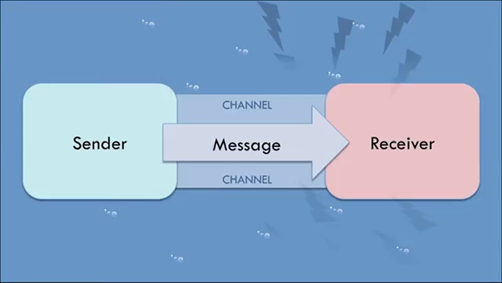
- ==Interactive Model of communication==
- ==Encoding==: process of creating meaning into a specific form of a message
- ==decoding==: process of extracting meaning from a message
- ==feedback==: response to a message
- ==noise==: interrupters in the environment of the message
- physical/external- literally physical noise
- psychological/internal- might affect one of the senses which will impact ability of message to be sent and received
- semantic/social- using words known by fewer ppl
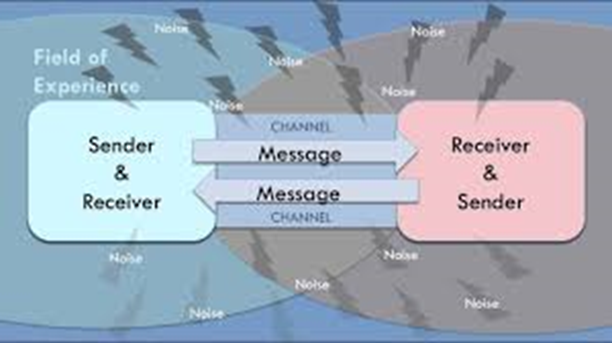
- ==Transactional model of communication==
- ==mutual influence==: ongoing and active contribution/influence of all parties in the communication process
- ==transactional==: simultaneous and mutually influential process of encoding and decoding messages
- ==communicator==: the sender/encoder and receiver/decoder in the communication process
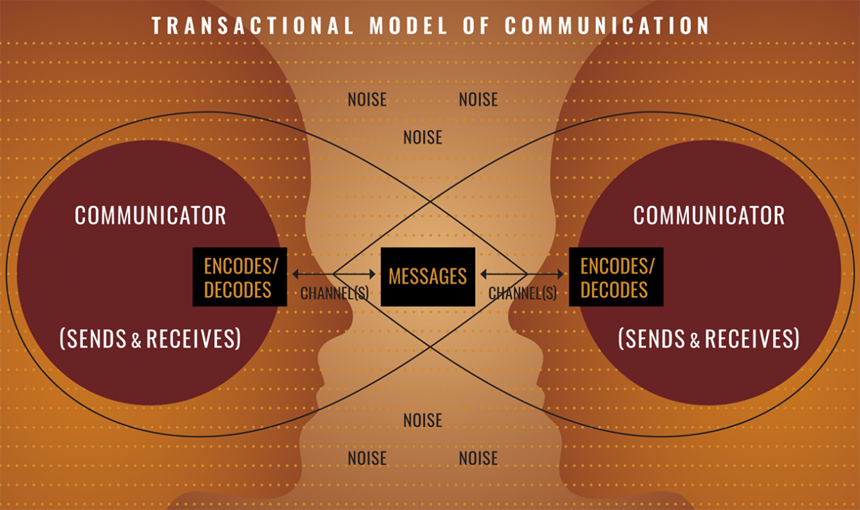
- ==Lasswell’s model==
- Context: productive process of communication effects
- who → says what→ in which channel→ to whom→ w what effect

- ==Shannon-Weaver model==
- Mediated Communication
- Context: communication w others via a device or tech
- info source: communicator originating the message
- message: the info sent directly by the source
- transmitter: the device sending the message
- signal: the form in which the message is sent via the device
- noise source: interference w message transmission
- received signal: the device receiving the message
- received message: what is actually produced by the receiving device after receiving the signal
- destination: indivi who is the target of the mediated message
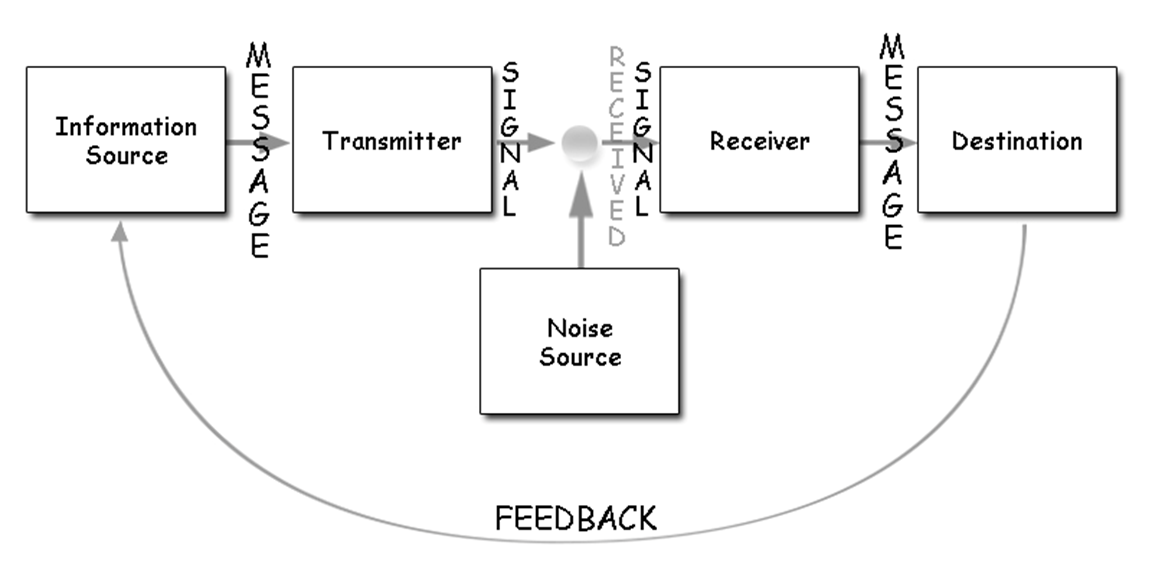
- ==Gerbner’s Model==
- Context: journalism- describes the process of observation and communication of observed events: perception and representation
- Perceptual dimension
- E- event that is perceived by a person
- M- person
- E1- perception of the event through objective and subjective interpretation
- Means and control dimension
- S- form: availability of channels of the source; particular characteristics of chosen channel(s); skill of message source using chosen channel (s)
- E- content: info abt the event
- SE- statement construct by source abt the event
- lower horizontal arm
- M2- destination: a decoder (audience) interprets the info received via the channel used by the source (M)
- SE1- perceptual filtering in the decoding process generated an interpretation of event

- ==Berlo’s SMCR model==
- Context: complexity to achieve fidelity (accuracy) in comm
- interdependent components w/in basic linear elements
- Source
- communication skills: skill of the invid to communicate
- attitudes: attitude towards audience, subject and oneself
- knowledge: communicator needs to be knowledgeable in the subject
- social systems: values, beliefs, culture, and a gen understanding of society
- culture: also comes under social systems
- message
- content: body of the message
- elements: non verbal cues
- treatment: the accuracy of the message being conveyed
- structure: how the message is arranged
- code: the form and means in which it was conveyed (eg- body language, gestures etc)
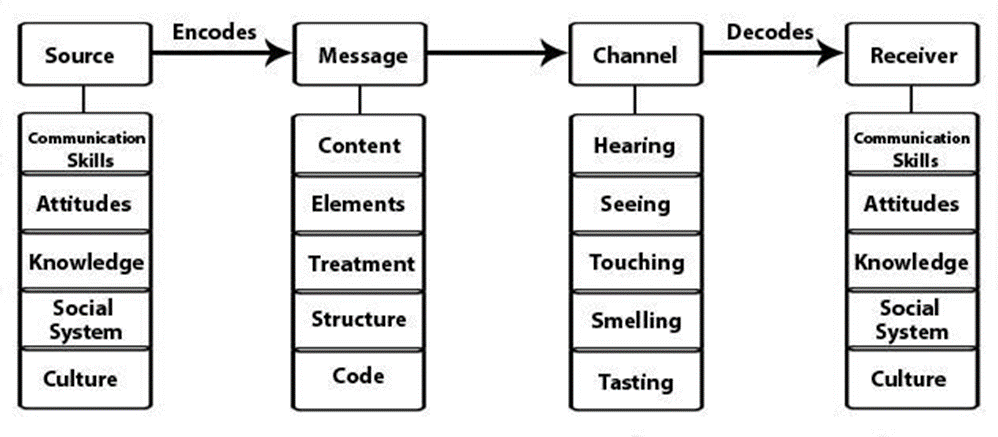
- ==Westley-Maclean model==
- Context: journalism
- A- reporter (observer)
- C- editor (gatekeeper)
- B- audience (receiver)
- f- feedback
- X^1- message
- X^11-modified message
- X1- info
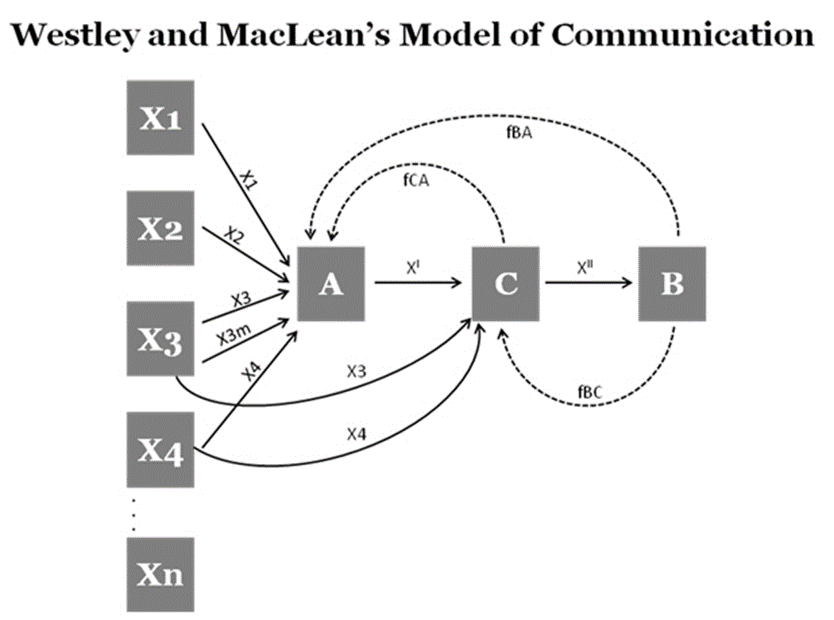
- ==the convergence model==
- Lawrence Kincaid (1979)
- Context: Processual communication- change in communicators’ relationships, the understanding of each other, and continuing communication together over time. focuses on global tendencies in comm exchanges
- “and then…”- any comm interaction is based upon what has come before and is part of a larger system and is part of a layer system of communication
- A+B: communicators who interact in cyclical patterns of information sharing (I1)
- each interaction represents a transaction in which participants express and interpret information
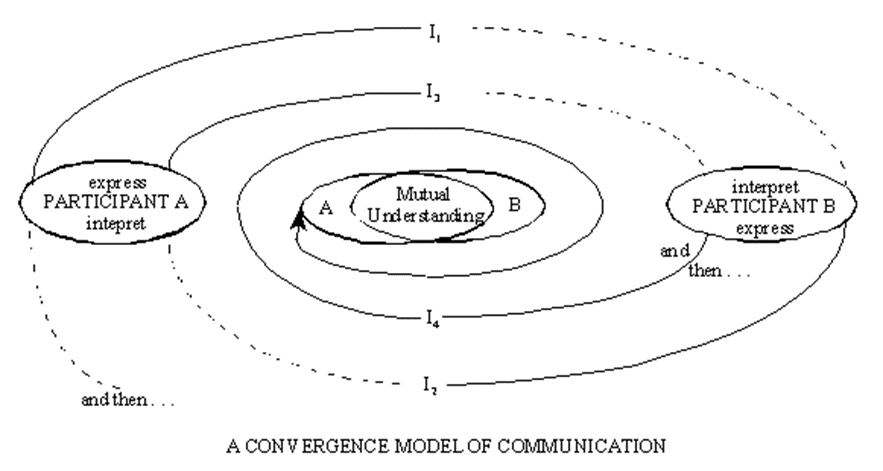
Week 3
- ==Perception==- the process by which we make sense of the world around us
- Using senses to acquire info abt the surrounding environment to situation
- Active perception- your mind selects, organizes, and interprets that which you sense
- Physiological process-receiving info through our senses of sight, hearing, touch, taste, smell
- Cognitive- the sorting, organizing, and interpreting of our senses
- Subjective perception- uniquely constructed meaning attributed to sensed stimuli
- Psychological influence-own mental outlook shapes our own thought processes, character, and experience
- Social influence- communication interaction of and with others
- Our communication should exist before any perceived reality
- our perception creates the world which requires comm
- comms is based on perception not on reality
- Perception process
- Selection
- How we choose which sensory info to process
- Organization
- How we arrange or order that info
- Interpretation
- How we attach meaning to that perception
- Selection process
- frequency: things that occur repeatedly
- contrast: things that stand out in some manner
- intensity: things are particularly strong or extreme versions of a phenomenon
- novel: things that are new to us
- Other influences
- Own individual characteristics- past experiences, socialization, knowledge and social roles
- Social factors- social media, mass media
- Consciously focusing on stimuli- narrow focus on an item
- errors in selection
- omission: inaccurate perception of events due to not selecting an important piece of information for processing
- distortion: the incorrect prioritizing of what info is essential or imp
- oversimplification: selection of unnecessarily significant info for a superficial or oversimplified understanding of something
- Organization process
- ==cognitive schemata==: mental framework that are applied when organizing information about a situation, event, person etc
- established through experience, socialization, familiarity, and biological ‘hard wiring’
- types of schema
- personal constructs
- physical constructs: how ppl are organized according to their physical attributes
- role constructs: ppl are organized based on their social role and position
- interactional constructs: ppl are organized based on their social and interactional qualities
- psychological constructs: ppl are organized based on their disposition or personality traits
- ==prototype==: idealized representation that is most representative of a category and its qualities
- scripts: a cognitive framework for an event or action
- chronological or sequential to anticipate future/ongoing events or actions
- series of events and linked responses
- govern our behaviour is familiar occurrences
- figure and ground
- figure- the focal point
- ground- the bg against which your focused attention occurs
- closure
- tendency to fill in missing info to complete your perceptive understanding
- proximity
- the principle that items physically close to each other will be perceived as a unit or whole
- similarity
- elements grouped together bc they share attributes like size, colour, or shape
- Interpretation
- subjective interpretation of associations of meaning we have learned for numerous stimuli as part of our culture, socialization, and past experiences
- attributions and context-
- context- perceived rules, norms, and principles that govern our behaviour in the short and long term, in familiar and unfamiliar settings
- attributions- assigning cause to behaviour
- internal- external locus of control; cause of behaviours is w/in the person or beyond their control- eg. failed an exam due to bad study habits or exam is too difficult
- stability- short or long-term behaviour- eg. failed an exam due to tiredness or dyslexia
- control- ability to exercise control over his/her actions- eg. failed an exam bc went to an all-night party the night before
- tendencies in perception
- self-serving bias- judge ourselves more tolerantly than we judge other by overemphasizing situational explanations for our own actions
- fundamental attribution error- tendency to assume the cause of the behaviour is with the person
- out-group homogeneity- tendency to view out-grp member as more alike than in-grp members
- persistence of first impressions- we tend to send out, infer, or assume evidence that confirms our initial reads